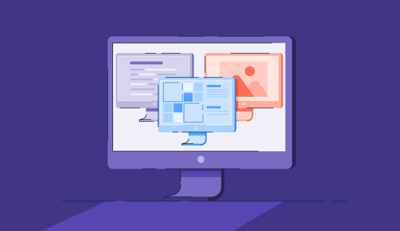April 19, 2021
 by Dibyani Das / April 19, 2021
by Dibyani Das / April 19, 2021

We have moved past the age of bulky computers and messy networks.
The world today runs on virtual platforms. Businesses have gone virtual, and software, most of all, has moved out of physical constraints. It’s now shared globally over the internet. Cloud adoption has created major ripples in the software industry, making it even easier for technology companies to expand.
Infrastructure-as-a-Service is one of the pathbreaking business delivery models that support cloud-based services.
Infrastructure-as-a-Service is a computing infrastructure that’s available and managed over the internet. IaaS is an online service that replaces the need for physical computing resources.
IaaS provides fundamental computing resources to organizations as per their business demands. It enables consumers to scale their computing power as their business requirements increase and efficiently utilize computing resources. IaaS provides a fast-paced solution for businesses to scale their application development needs and share their IT infrastructure with their customers.
IaaS offers resources and services such as virtualization, network, storage, and servers. It identifies the resources needed by an organization and the ones available with a cloud service provider. IaaS connects the organizations to the appropriate cloud providers and then allows them to pay for the resources it needs.
It works as a middleman between the organizational needs and the services provided by the cloud. IaaS helps map business requirements to an appropriate cloud platform and handles the billing of the services offered.
If you’re in tech, you would’ve probably heard of IaaS, PaaS, and SaaS. They define how an organization uses cloud services.
Infrastructure-as-a-Service allows organizations to use cloud computing models instead of on-premises infrastructure. It’s highly scalable and allows users to pay as per their usage instead of spending on the hardware setup.
Platform-as-a-Service provides organizations with the hardware and software tools needed to build and run applications. It’s highly accessible and can be used by multiple users to build different applications simultaneously.
Software-as-a-Service provides users access to software over the internet. It allows them to access applications directly over a web browser and is very time and cost-effective.
.jpg?width=590&name=IAAS%20vs.%20PAAS%20vs.%20SAAS.%20(5).jpg)
IaaS is used in different business scenarios. For businesses of all sizes, IaaS provides excellent support for cloud computing services and adoption.
IaaS speeds up the software development and testing process and helps businesses grow faster. Development environments can be easily set up and reused with IaaS, thus enabling developers to push out more business applications.
Data backup and recovery are major use cases of the IaaS platform. It provides a flexible storage platform for your business data and safeguards it from unexpected data loss or surge.
High-Performance Computing (HPC) is a term used for the processing power of supercomputers or computer clusters. IaaS provides a scalable platform for these complex problems to be worked on.
IaaS provides the infrastructure to support all kinds of web applications and also helps ship them out faster. Companies have an option to scale their application infrastructure according to the market demands.
For companies processing huge amounts of data, commonly known as big data, the IaaS model provides a robust processing environment at a nominal cost.
With a projected market share of over 200 billion dollars by 2027, IaaS has been making ripples in the global business landscape. It has some very lucrative benefits attached to it, making it a desirable environment for companies to adopt.
IaaS vendors provide a pay-as-you-go model to organizations, which allows them to pay only for the services they use. It decreases their expenditure on static resources and boosts their computing speed with little to no hardware costs. This pricing system allows companies to cut down on unnecessary and dormant service models.
Once you have onboarded an IaaS environment, you need not worry about replacing the hardware, software, or network equipment connected to it. It provides on-demand scalability to support your future demand for applications, functionality, and storage.
IaaS also assists in virtual office environments by providing business data access to employees regardless of their geographical location. Increased accessibility also means that your business is not interrupted due to remote working scenarios.
IaaS provides business continuity even when physical servers or data centers are impacted due to natural or man-made disasters. This increases the business uptime, and the organizational infrastructure is not affected.
For organizations using Infrastructure-as-a-Service as part of their cloud migration process, it’s inevitable to face a few complexities surrounding the IaaS environment.
While setting up a cloud environment with a new IaaS provider, you need to ensure that it, along with your existing service level agreements, system architecture, object storage, operating systems, is properly configured and able to support the business applications you need.
Visibility is a big aspect to consider when choosing an IaaS environment. Each stakeholder in your organization who uses the business applications onboarded to an IaaS environment should have a clear idea of which resources were outsourced and how it’ll impact their working environment.
Security is a major concern when it comes to outsourcing your business infrastructure to a vendor. You need to ensure that the strictest security protocols are in place before you onboard an IaaS vendor to handle your business.
Business applications that adhere to certain government regulations and compliance policies need to uphold them when an IaaS vendor is onboarded. It’s imperative to check beforehand if your vendor is aware of the compliance protocols that your organization needs.
Using an IaaS environment means heavy reliance on your vendor. Suppose your vendor doesn’t support certain applications due to scalability or bandwidth issues. It’ll cause a major disruption in your business, and you’d probably have to switch over to a different vendor.
Infrastructure-as-a-Service provides organizations with an accessible, flexible, and scalable option for adopting cloud-based services through third-party vendors. It’s delivered through public cloud infrastructure, virtual machines, and servers.
To qualify for inclusion as a top IaaS provider, a solution must:
*Below are the five leading IaaS solution providers from G2's Spring 2021 Grid® Report. Some reviews may be edited for clarity.
Amazon EC2 provides a scalable solution for cloud computing resources and helps organizations support their cloud premises with a pay-per-use model.
“Amazon EC2 comes with the Amazon Web Service's Free trial bundle of 12 Months, so one can easily opt-in for AWS EC2. AWS EC2 is enough itself to complete one's server requirements. One can use these servers to host their blogs, portals, API’s or complete websites without so much knowledge.”
- Amazon EC2 Review, Pooja M.
“Although it's difficult to find things to be disliked in AWS EC2, some features still need improvement like setting up Load Balancers or CloudFront still requires a lot of knowledge and time. According to my personal opinion, the availability of AWS EC2 servers across the countries could be increased to improve the latency.”
- Amazon EC2 Review, Akhil K.
Google Compute Engine enables virtual machine launch on command for businesses. It supports Google Cloud Platform and provides a scalable number of virtual machines for building large compute clusters.
“Compared with its rivals, the quality of Google Cloud Platform is far higher. It has a cloud platform in design. It offers a large range of optimization choices for the online migration of virtual machines. Safety and efficiency are some of the best reasons to use Google as a service. It’s also one of the quickest IOs and one tap of SSH software-based console exposure. The hardware and products of Google are strongly incorporated with GCP.”
- Google Compute Engine Review, Marilyn M.
“Too many features are included in the same application, sometimes which takes me more time to explore features and support for the application. I need to call whenever I require support.
The product is not complex, but I dislike that there are millions of documents. I have to find and read all of them to get the exact solution for my to compute engine.”
- Google Compute Engine Review, Nitin K.
DigitalOcean Droplets provides Linux-based virtual machines for building a cloud-based infrastructure. It functions in the form of virtual droplets on top of virtualized hardware.
“I like digital ocean droplets specifically to host websites and web apps. These servers offer very good performance and are inexpensive. They also offer many addons like additional IP addresses, scheduled backups, etc. On top of that, I have full control of the machine from a developer point of view.”
- Digital Ocean Review, Anubhav R.
“Obtaining responses from DigitalOcean support may be slow and may not be adequate without an additional care plan, providing a low proportion to users of this platform, highlighting that it needs better increments for virtualization, generally highlighting that it requires new updates for better internal development for companies that use this software, as it currently has many drawbacks according to its design.”
- Digital Ocean Review, May L.
Azure Virtual Machines support the virtualization of software development, testing and provide a virtual private cloud environment to run your business applications.
“Microsoft Azure Virtual machines are supported like the original server and use its managing power full tool. We can experience it like it's an original physical machine held in our lab. Having the best experience to manage many hosts within-host, so it’s a great powerful platform.”
- Azure Virtual Machines Review, Nileshkumar P.
“When the VM RDP/SSH connection fails, it's really hard for the users to get it to fix by themselves. Yes, there is redeploy, reset the password, run commands, and serial console, but it doesn't help us get it to fix for the customer.”
- Azure Virtual Machines Review, Tony A.
Virtual Machine Manager allows organizations to run multiple virtual machines and allocate resources among them.
“It's a very simple and robust tool which is very useful for VDI management. Like the easy implementation and analytics part.”
- Virtual Machine Manager Review, Vishwanathan K.
“More features can be added to reduce the addition of other consoles.”
- Virtual Machine Manager Review, Sumit G.
IaaS helps companies optimize their resource utilization and pay for just what they need. It creates a robust feedback system that informs the organization about its application and infrastructure needs.
IaaS can reduce your data storage footprint with cloud infrastructure by providing you with the perfect cloud solution for your business.
Dibyani is a former Content Marketing Specialist at G2. In her free time, you can find her scribbling fanfiction and brushing up her knowledge on various fandoms (Harry Potter, mostly).
The cloud reigns supreme in today's era of digital evolution. It gives organizations of all...
 by Samudyata Bhat
by Samudyata Bhat
In the ever-evolving computing landscape, virtualization is the technology that transforms...
 by Harshita Tewari
by Harshita Tewari
A virtual private cloud (VPC) is a private cloud-like computing environment within a public...
 by Sudipto Paul
by Sudipto Paul
The cloud reigns supreme in today's era of digital evolution. It gives organizations of all...
 by Samudyata Bhat
by Samudyata Bhat
In the ever-evolving computing landscape, virtualization is the technology that transforms...
 by Harshita Tewari
by Harshita Tewari


